You're better off swapping in XT150's and avoiding any potential phase wire melting issues.
You are using an out of date browser. It may not display this or other websites correctly.
You should upgrade or use an alternative browser.
You should upgrade or use an alternative browser.
Leaf / leafmotor / leafbike high efficiency 1500w motor
- Thread starter neptronix
- Start date
The Toecutter
100 kW
- Joined
- Feb 8, 2015
- Messages
- 1,414
I did that with the 3T. Also have 8AWG after about an inch out the axle. Ferrofluid and hubsink. Never seen more than 85C temperature inside the motor at 10 kW and 46.8V/200A. Planning to run 12kW to it when I have the trike rebuilt with body and added front motors. With the added thrust from the front wheels, the trike should be at top speed in seconds like that, theoretically preventing the Leafbike motor and wiring from overheating.You're better off swapping in XT150's and avoiding any potential phase wire melting issues.
The 4T quickly developed issues and I saw it as sacrificial at the time, and brief 10 kW applications is how I fried the Hall effect sensors and melted some bullet terminals. 12AWG was all it had, which was obviously insufficient. The temp sensor stopped working due to a wire getting yanked so I do not know how hot it got, but it clearly gets hotter much more quickly than the 3T at 10 kW. I ended up reusing it in the mountainbike, where it will live a greatly easier life henceforth at 750-1500W. Halls, bearings, and connectors have been replaced. Internal wiring seems good but has some melted insulation going into the axle, which may be the cause of a stutter upon takeoff due to a possible short?
Last edited:
ebike4healthandfitness
100 kW
- Joined
- May 19, 2012
- Messages
- 1,131
Yes, rider position makes a huge difference.It's mostly due to aerodynamic differences in rider position for the various bikes you selected.
You can see how much of a difference rider position makes by comparing the 3rd calculation (road bike on tops) with the 6th calculation (road bike in drops) back in post #3146 -->Leaf / leafmotor / leafbike high efficiency 1500w motor . Same rider height, same rider weight, same bike weight, same bike type and same tires but power requirement at 40 mph goes from 1330 watts (using drops of road handlebar) to 1902 (using tops of road handlebar). This is a 43% increase.
ebike4healthandfitness
100 kW
- Joined
- May 19, 2012
- Messages
- 1,131
It's plausible to put an aggressively aero riding position on an e-bike, but when most of your power isn't from pedals, that can get foolishly uncomfortable in a hurry.
Not sure what you mean by this but I like drop bars far more than the flat bars typically found on mountain bikes.
Road drop bars IMO are far more efficient, comfortable and versatile. I suppose the main problem people have is when they set the primary riding position as the hoods. This because they find the hoods position to be the best one for shifting with the brifters. Trouble is when setting the hoods as the primary handlebar position (when seated) is that the drops become uncomfortable because instead of lengthening the cockpit when the person drops down they shorten it instead (because they are moving from a higher forward position (the hoods) to one that is lower and more rearward (the drops). This is no good. Proper set-up is to make the drops the primary seated position and reserve the hoods for standing (because when out of the saddle the body naturally moves up and forward making the hoods the proper handlebar riding position for that transition).
Last edited:
The Toecutter
100 kW
- Joined
- Feb 8, 2015
- Messages
- 1,414
I'd really love to get dyno access to see if 12kW actually makes more usable power to the road than 10 kW, or whether I'd be losing it to heat. I think it will take 12 kW, but if it's not of any benefit, I'd possibly just be damaging the motor prematurely.I love hearing that the biggest problem with running >= 10kW on this motor is burning connectors and halls, that stator is a beast!
I'm eventually going to try 12 kW though. The front motors make me more confident I won't destroy shit, due to getting it out of its high current area of the torque vs rpm curve much more quickly than if the bike was just powered by a single rear Leafbike motor.
This motor has exceeded my expectations thus far. A bit over 20,000 miles on the 4T, maybe 300 miles on the 3T thus far.
My biggest complaint is that it is too wide to fit into my Milan SL's rear wheel well, and I had to by a thinner Grin All-Axle rear to use for it. But at least the 4T is getting a 2nd life on the mountainbike.
ebike4healthandfitness
100 kW
- Joined
- May 19, 2012
- Messages
- 1,131
This is relevant to us because most of us need tougher tires than recreational or sport riders would use.
Road bike in drops with various different tires (from highest power consumption to lowest power consumption):
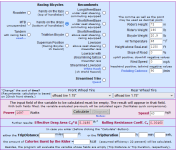
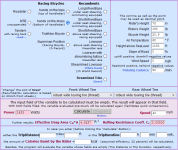
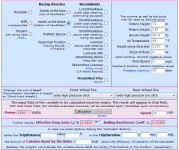


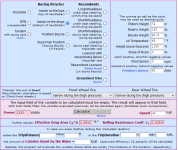
Versus unsuspended mtb bike with narrow racing tires (high pressure):
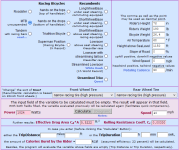
And LWB recumbent with narrow racing tire (high pressure):
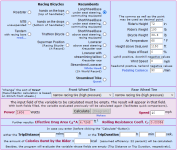
In a nutshell, road bike in drops beats unsuspended mtn bike with narrow high pressure tires by a good margin even when using 1.75" knobbies (1698 watts vs. 1824 watts) and LWB recumbent with narrow racing high pressure tire only beats road bike in drops using 1.75" knobbies by 92 watts (1606 watts vs. 1698 watts).
With that noted, I would love to see how a narrow racing high pressure tire LWB recumbent fares against a road bike in drops (with shorter cranks for aero gain) using 1.75" knobbies.
Does crank length matter?
Crank length can be used as a tool to improve fit related issues impacting comfort, power, and aerodynamics.
"Using shorter crank can improve:
Comfort: A shorter crank length reduces range of motion at the knee (extension and flexion), hips, and low back.
Power: A shorter crank alone will not increase your power output, but it can be used to reduce restriction through the top of the pedal stroke by opening up an impinged hip angle and/or reducing knee flexion. Going back to our definition, if we reduce restriction than power output can increase.
Aerodynamics: Going to a shorter crank will allow you to ride at a lower back angle which minimizes frontal surface area improving aerodynamics."
My prediction is the roadbike with 1.75" knobbies would beat the LWB recumbent with narrow racing high pressure tires (Re: shorter cranks would improve aero on road bike but not LWB recumbent)
Attachments
Last edited:
ebike4healthandfitness
100 kW
- Joined
- May 19, 2012
- Messages
- 1,131
Efficiency isn't everything. Maybe you want to be at a close to ordinary tallness so you can get the best view and crouch only when you are doing like 60mph/100kph..
View attachment 356537
Sometimes safety > efficiency!
Road drops allow ordinary tallness. All you have to do is transition from the drops (the primary seated handlebar position) to the tops (secondary seated handlebar position). This transition is very ergonomic as well because becoming more upright naturally shortens the cockpit (i.e. when moving from drops to tops the reach decreases and the handlebar height increases.)
The Toecutter
100 kW
- Joined
- Feb 8, 2015
- Messages
- 1,414
A velomobile greatly improves both over and upright or open recumbent.Sometimes safety > efficiency!
You know you''re pushing 'enough' power through it when you replicate LFP's results from 13 years ago!
The LWB you selected is NOT accurately representative of many LWBs,...and arguably the worse 'bent aerodynamically.My prediction is the roadbike with 1.75" knobbies would beat the LWB recumbent with narrow racing high pressure tires (Re: shorter cranks would improve aero on road bike but not LWB recumbent)
USS (under seat steering) places the arms and hands vertical, widening the frontal profile - Ass (above seat steering) places the arms horizontal and parallel with direction of travel - significantly reducing frontal profile.
Last edited:
Chalo
100 TW
I find it much easier to implement, and much easier to live with, to add power and energy rather than adding bodywork of any kind.
The bicycle industry as a whole, for generations, has come to the same conclusion even when there's no power upgrade available.
The bicycle industry as a whole, for generations, has come to the same conclusion even when there's no power upgrade available.
ebike4healthandfitness
100 kW
- Joined
- May 19, 2012
- Messages
- 1,131
The LWB you selected is NOT accurately representative of many LWBs,...and arguably the worse 'bent aerodynamically.
USS (under seat steering) places the arms and hands vertical, widening the frontal profile - Ass (above seat steering) places the arms horizontal and parallel with direction of travel - significantly reducing frontal profile.
If we compare the USS SWB recumbent to the OSS (over seat steering) SWB recumbent both using the same tires the difference in aero works out to be 279 watts. This assuming the only difference between the commuter equipped USS SWB and the racing equipped OSS SWB was the tires. I'll bet the difference between the two bikes is more than that, but I will go ahead and give the benefit of the doubt to OSS being worth 279 watts over USS.
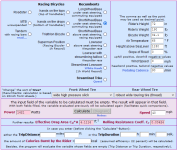
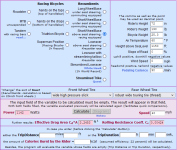
Okay so now if we were to swap out the USS for OSS on the default tire LWB the power consumption should drop from the 1806 watts (as shown below) to 1527 watts (re: 1806 - 279 = 1527):
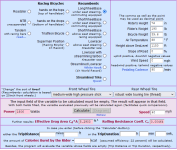
And if we swap out USS for OSS on the LWB with narrow high pressure racing tires (as shown below) power should decrease from 1606 watts to 1327 watts (re: 1606 - 279 = 1327):
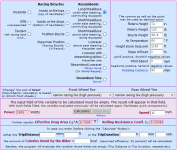
1327 watts for a LWB recumbent with OSS and narrow high pressure racing tires just barely beats the road bike (in the drops) with narrow high pressure racing tires by 3 watts (i.e. 1327 watts vs. 1330 watts).
But as I mentioned in my earlier post ( Leaf / leafmotor / leafbike high efficiency 1500w motor) recumbents won't benefit from the gains in aero positioning possible by using shorter cranks. A recumbent also cannot benefit from the aero gains created by using a dropper seatpost which can be very substantial.
Here is a test GCN tech did a test with a very short travel dropper post vs. super tuck position vs. non dropper post:
(^^^ That picture above is the super tuck position not the dropper post position )
Imagine how much better that would have been with a much longer travel dropper post. I have seen up to 240mm travel dropper posts in 31.6mm diameter. In contrast, the dropper post used in the GCN tech video was like 100mm as shown in the portion of the video I linked below:
Last edited:
Hog wash.1327 watts for a LWB recumbent with OSS and narrow high pressure racing tires just barely beats the road bike (in the drops) with narrow high pressure racing tires by 3 watts (i.e. 1327 watts vs. 1330 watts).
Ok, Mr. Ai,... Do you even own a bicycle? Seems the best you can offer.is generic data with generic vehicles. Spend a day at Battle Mountain and learn something.
I could give a shit less about speed. I ride recumbents specifically for their ergonomic superiority. A topic you know nothing about.
Last edited:
Hey I feel the same way and ride recumbents too, but let's try a keep it respectful and on topic guys.
ebike4healthandfitness
100 kW
- Joined
- May 19, 2012
- Messages
- 1,131
The recumbents used in that race are in no way like a unfaired LWB recumbent as far as aerodynamics go.Spend a day at Battle Mountain and learn something.
I can't even believe you would bring those up as a valid comparison point in a discussion about unfaired LWB recumbents vs. road bikes.
Chalo
100 TW
I ride recumbents specifically for their ergonomic superiority. A topic you know nothing about.
"Superiority". Helpless to even surmount a curb or edge. Victims of any pavement flaw. How superior is that in today's world?
They're wheelchairs for people who need wheelchairs.
The Toecutter
100 kW
- Joined
- Feb 8, 2015
- Messages
- 1,414
New project. Trike, customer wants it to go fast"Superiority". Helpless to even surmount a curb or edge. Victims of any pavement flaw. How superior is that in today's world?
They're wheelchairs for people who need wheelchairs.
A wheelchair for those who are so desperately incontinent that they must speed between lavatories.
Nice if you need that sort of thing.
LOVE IT.
G.
I don't need a wheelchair nor am I incontinent, but I love mine regardless. It "goes" really nice with the Leafbike. I've drag raced cars at stoplights. Full suspension with gas shocks and about 2" travel really helps with bad roads, and it has a more comfortable ride than some cars I've ridden in. I never have to worry about accidentally falling over at stoplights if I'm drunk and/or on a myriad of other substances, either.
Peace.
Last edited:
Chalo
100 TW
Yours isn't really a wheelchair. It's more like a shot glass quantity of car. It doesn't seem like recliner comfort scored too high on the order of priorities. even if it turned out OK in that regard.
Anyway I think it's funny that Papa would boast about the ergonomics of a pedal vehicle that's so intractable to push while walking, to park and lock up, to put in a repair stand, to bring through a door....
At work we just recently managed to sell, after months, a Longbikes Slipstream LWB 'bent that had been in the way. It occupied as much space as three bikes and never would agree to stand up for very long at a time.
Anyway I think it's funny that Papa would boast about the ergonomics of a pedal vehicle that's so intractable to push while walking, to park and lock up, to put in a repair stand, to bring through a door....
At work we just recently managed to sell, after months, a Longbikes Slipstream LWB 'bent that had been in the way. It occupied as much space as three bikes and never would agree to stand up for very long at a time.
The Toecutter
100 kW
- Joined
- Feb 8, 2015
- Messages
- 1,414
Yours isn't really a wheelchair. It's more like a shot glass quantity of car. It doesn't seem like recliner comfort scored too high on the order of priorities. even if it turned out OK in that regard.
There was a time I was riding it with the body removed, and someone in a minivan followed me for about a half mile on some side streets, then yelled out his window, "Can I get your autograph?" I asked him "Why?" He thought I was a crippled teenager using a special kind of wheelchair bike to go everywhere around the city. I stood up and showed him that was not the case and explained to him what the vehicle was.
Superb_Raccoon
1 W
Inline wheelchair?"Superiority". Helpless to even surmount a curb or edge. Victims of any pavement flaw. How superior is that in today's world?
They're wheelchairs for people who need wheelchairs.
I've chosen to use the cassette version of the Leaf motor.
- The motor is 137mm in width. What is the actual O.L.D. width from your experience with space for a disk brake? Around 140mm?
- Is there a way to resize the motor to fit better in 135mm dropouts? Grinding or something similar? Because of the disk brake, if possible, maybe this has to be done on the cassette side?
- Is waterproofing the motor recommended and if yes, what glue/silicone is the best?
- Is the Grin Tech Torque Arm V7 a good choice and sufficient for use on aluminum frames?
- Do you recommend lacing the motor myself (I don't have experience) or should I find a nearby workshop to do it for me? Can I measure everything myself and use the Grin Tech spoke simulator for the lacing or do I need additional information from Leaf (like dishing offset, etc.)?
Similar threads
- Replies
- 13
- Views
- 1,194
- Replies
- 2
- Views
- 312
- Replies
- 8
- Views
- 1,372






